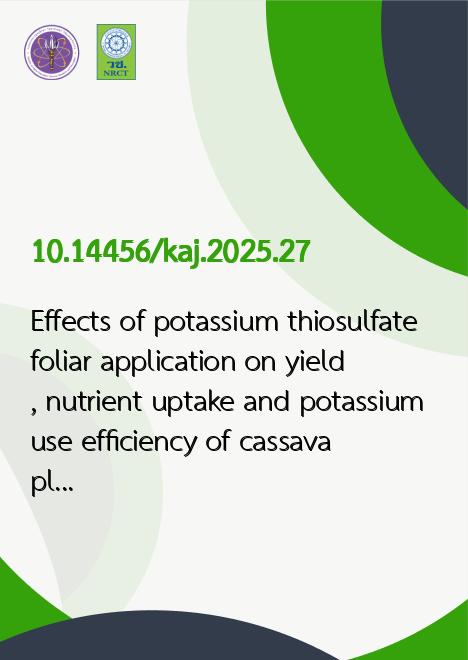
|
Effects of potassium thiosulfate foliar application on yield, nutrient uptake and potassium use efficiency of cassava planted in Satuk soil series |
|---|---|
| รหัสดีโอไอ | |
| Creator | Somchai Anusontpornperm |
| Title | Effects of potassium thiosulfate foliar application on yield, nutrient uptake and potassium use efficiency of cassava planted in Satuk soil series |
| Contributor | Nattapong Worapoje, Suphicha Thanachit, Mutchima Phun-iam |
| Publisher | Faculty of Agriculture |
| Publication Year | 2568 |
| Journal Title | Khon Kaen Agriculture Journal |
| Journal Vol. | 53 |
| Journal No. | 2 |
| Page no. | 364-381 |
| Keyword | potassium thiosulfate, potassium chloride, foliar application, cassava, nutrient use efficiency |
| URL Website | https://li01.tci-thaijo.org/index.php/agkasetkaj |
| Website title | Khon Kaen Agriculture Journal |
| ISSN | 3027-6497 (Online) |
| Abstract | Potassium fertilization is less effective in sandy soils, resulting in higher costs with unsatisfactory cassava fresh tuber yield return. This study was carried out to comparatively investigate the efficiency of potassium chloride (KCl) and potassium thiosulfate (KTS) foliar application, and KCl soil application and their impact on cassava yields. A single-year field experiment was conducted in a farmer field in Nakhon Ratchasima province with Satuk soil series as a representative soil of the experimental area. The experiment was arranged in a randomized complete block design with four replications. Seven treatments comprised no K fertilization, 50 and 100 kg K2O/ha KCl soil application, 50 and 100 kg K2O/ha KCl and KTS foliar application. The cassava, Huat Bong 80 variety was a tested plant and harvested at 10-month-old. The KCl and KTS foliar application at the rate of 50 kg K2O/ha significantly increased fresh tuber yield by 73.0% and 68.8%, respectively, over the control (22.05 t/ha) but the higher rate (100 kg K2O/ha) did not boost the yield over the lower rate. It was also the case for starch yield. Both rates of KCl soil application gave much inferior yields to the highest ones. The KCl and KTS foliar application at the rate of 50 kg K2O/ha also significantly promoted the highest N and P uptake whilst the KTS foliar application at the rate of 100 kg K2O/ha significantly induced the highest K and S uptake in cassava. The KCl and KTS foliar application at the rate of 50 kg K2O/ha had the significantly highest agronomic efficiency and partial factor productivity with the latter significantly having the highest apparent recovery efficiency. The KCl and KTS foliar application at the rate of 50 kg K2O/ha can be a better alternative K fertilization for increasing cassava yield in this soil due to their high K use efficiency. |
